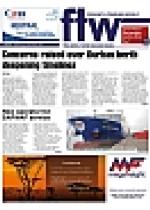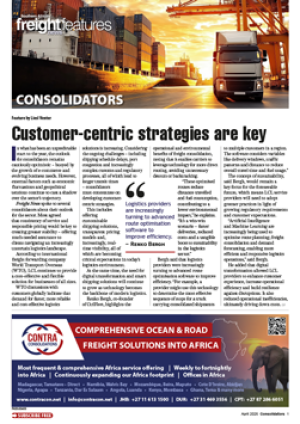Manganese and iron ore mines
in the Northern Cape – which
are major exporters – are
busy laying off large numbers
of staff, slashing costs and
substantially trimming
production after the collapse in
commodity prices.
But, while this may be
disastrous news for mine
workers in the Sishen area,
which has no other jobs
available, it could be good
news for Transnet Freight
Rail (TFR) and Transnet Port
Terminals (TPT).
Iron ore prices fell about
35% in 2015 to prices less
than a quarter of their peak
in 2011 due to a supply glut
and growth concerns in top
consumer China.
Anglo American’s Kumba
Iron Ore CEO, Norman
Mbazima, said last July that
it was able to withstand iron
ore prices of US$45 per ton.
“If prices decline significantly
below that, we have to think
again about our business and
what to do about that,” he
added. But, by December 11,
ore prices had bottomed out at
$38.30, a record low in daily
prices going back to 2009,
Metal Bulletin data showed.
By last Friday, the futures
price was still below that
breakpoint, at $44.04,
according to barchart. And it is
expected to decline throughout
the year, falling to $35.22
by December; to $32.81 by
December 2017; and $32.04
by December 2018.
So that indicates at least
three years of loss-making
export prices
for SA’s iron ore
export mines.
To date,
this has forced
Kumba to
cut jobs and
restructure
its main mine
at Sishen. It
is currently
busy laying off
almost 4 000
in-house and
contractors’
workers –
and whispers around the
marketplace hint at lossmaking
global ore prices
possibly leading to the mine
being temporarily mothballed.
At the same time, about 620
jobs will be cut at the South32-
Anglo American manganese
joint venture (JV), also at
Sishen in the manganeserich
Kalahari Basin in the
Northern Cape – home to
80% of the world’s known
manganese ore resources.
And, while manganese
output will resume following
a suspension and strategic
review, this
will be at a
“substantially
reduced rate”,
taking about
900 000
tonnes out of
the market,
said a South32
statement.
Also, the
JV’s Metalloys
alloy plant
– one of the
largest smelters
in the world
– still has
three of its four high-carbon
ferromanganese furnaces
standing idle.
This will have enormous
impact on TPT and TFR
operations in the region –
which have concentrated
on bulk to the exclusion of
almost all else. But it may be
put to advantage, according
to a knowledgeable observer
of the freight industry.
Transnet reintroduced
manganese exports through
Saldanha Bay in January
2014 to make up for lower
iron ore volumes. It therefore
has the capacity to handle the
commodity.
Manganese ore exports
were being routed through
Port Elizabeth because the
rail line to Saldanha was
dedicated to iron ore during
the commodity boom.
In this case, the question
arises whether TFR needs
to go ahead with the
upgrade of the line from
Sishen to Port Elizabeth to
support projected growth in
manganese exports.
Also, planned upgrades to
the Ngqura-Sishen railway
line and a new manganese
terminal in Ngqura could
possibly be shelved without
any loss of revenue – which
would support the bottom
line.
The ore can rather go via
Saldanha in place of the
lost volume of iron ore – the
preferred route of the mining
companies.
At the same time, TPT
could still go ahead and
close down the now-aged
manganese terminal at
PE – something that would
please the city’s residents,
because every time there is
an east wind their curtains
are covered with black dust
from the terminal stockpile.
It would also fit in with TPT’s
plans to make PE exclusively a
car export and fishing port.
TPT could also backburner
its plans to go ahead with the
proposed costly move of the
Port Elizabeth manganese
terminal to Ngqura – which is
part of its development plans
to make Ngqura a container
transhipment and bulk export
port.
FTW put these queries
before both TFR and TPT, but
no response had been received
before time of writing.
INSERT
The ore can rather
go via Saldanha in
place of the lost
volume of iron ore
− the preferred
route of the mining
companies.
CAPTION
Sishen mine... iron ore prices fell 35% in 2015.
Mining downturn could take the pressure off TFR
12 Feb 2016 - by Alan Peat
0 Comments
FTW - 12 Feb 16

12 Feb 2016
12 Feb 2016
12 Feb 2016
12 Feb 2016
12 Feb 2016
Border Beat
16 Apr 2025
Featured Jobs
New
New
